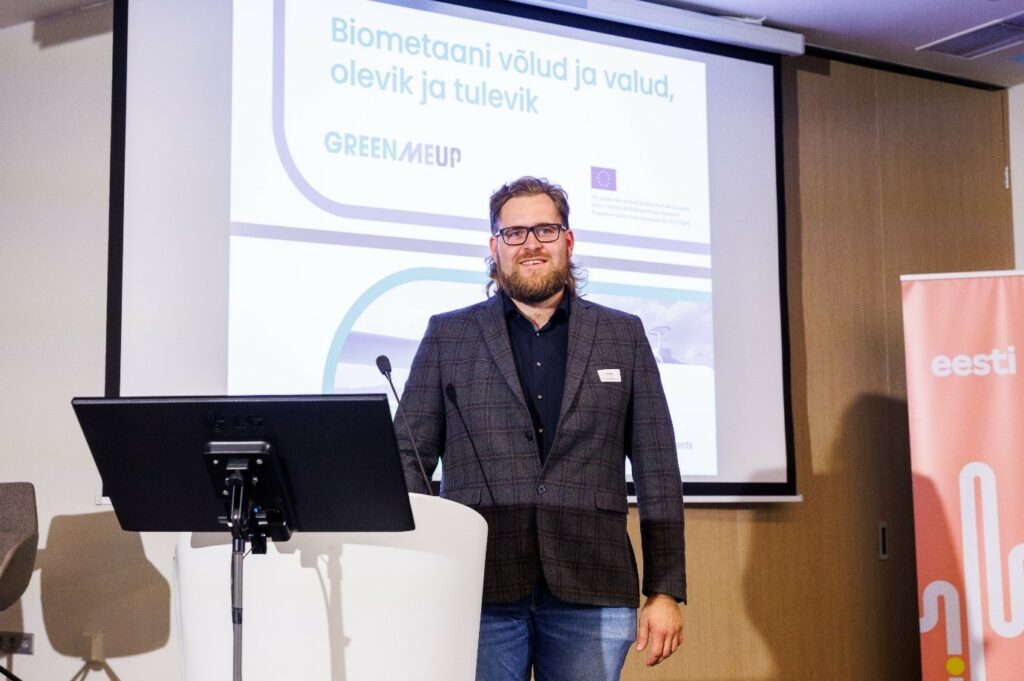This October, the Estonian Gas Union – an organization between Estonian gas market players – held its annual conference on 3rd October 2023.
This year, Estonian Biogas Association was represented by Ahto Oja and Lauri Jasmin who held a panel and made a presentation about Estonian Biomethane Market, together with a short introduction of the GreenMeUp Project and its main goals.
During the conference, it was good to see that all the presentations were focused on biomethane, gas-grid and road transport decarbonization.
The Conference was opened by James Watson, the secretary general of Eurogas, who gave an overview about where gas market in Europe is Heading.
After the introduction, the first presentation was held by Natasha Fielding from Argus media, and it was named “Forward looking gas market update in Europe.” This presentation was focused on gas market demand and possible upcoming risks in gas consumption during upcoming winter.
The third presentation was held by one of Estonia’s main players on natural gas market, Eesti Gaas. The presentation title was “Re-birth of gas market”, and also had a focus on bringing biomethane to the market.
First half of the day was finished by Joáo Gorenstein Dedecca from Trinomics, who presented preliminary version of the study “Gas decarbonisation pathways for the Baltic Regional Gas Market Countries”.
After lunch, the Conference continued with 2 presentations by Climate Ministry of Estonia:
The first one was held by Rein Vaks, who made a presentation about “REDIII green transport achievement by 2030 and role of Biomethane”, and was then followed by Silver Sillaks presentation about “New emission trading systems impact to domestic and transportation sectors”.
The third presentation in the afternoon was held by Alan Vaht from Alexela, one of Estonia’s biggest fuel retail sellers which has the largest fossil fuels portfolio, from all types of fossil fuels to BioLNG and BioCNG. This presentation was mainly focused on green transition of road traffic and possible risks along the way: here, one of the most remarkable topics was the description of risks with using HVO.
Next and final presentation was made by Estonian Biogas Association, with an in-depth analysis of Estonia’s situation in the biomethane sector. Regardless our fast growth in production during the last 5 years, a lot of companies are still facing risks and uncertainty regarding to gas price. In the end of the presentation, the following suggestions about market uptake mechanisms were made:
- To continue CNG/CBM market uptake in regional haulage and public transport.
- To support CBM/CNG, LBM/LNG equipment implementing in agriculture to lower emissions from agricultural companies
- To develop LBM/LNG infrastructure for wider usage of methane fuels in long haul road transport.
- To support biomethane liquefaction, for green LBM uptake on local market
- To support gaseous fuels usage in regional marine transport, since Estonia has significant amount of islands and transport between mainland and islands
- To support biomethane export so production could expand regardless regional market consumption
- Biomethane/biogas usage for peak electricity production
Between presentations, 6 representatives from fuel market, biomethane production and public sector held a panel conversation about Estonian gas market future and solution for bottelnecks between current situation and green methane uptake options for year 2030.
The Conference ended with a passionate political debate between 6 main parties of Estonian government. Coalition parties were more pro-biomethane, but opposing parties were a bit less supportive about the green transition. However, 2 out of 3 still expressed support towards biogas production uptake to create energetical independence. Nevertheless, the main risk they expressed was pointed towards energy prices which may rise with implementing green sources to the market.
According to the Estonian Biogas Association, this Conference outlined how public interest towards biomethane market uptake has been grown significantly. Also, politicians, farmers, waste treatment plants and gas market are working together to find good solutions for the market uptake obstacles.

